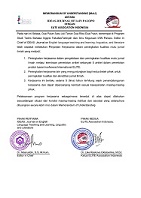Grice's Types of Maxims in "Willoughbhys" Movie
DOI:
https://doi.org/10.24256/ideas.v10i1.2661Keywords:
Keywords, cooperative principle, maxim, pragmaticsAbstract
This study aimed to find out the cooperative principle using the types of maxims. The main theory used in this study purposed by Grice (1975) the cooperative principle. And for the research design this study applied the descriptive qualitative as the method. As for collecting the data the researcher applied the theory of observational method and non-participatory technique by (Sudaryanto, 2015). Moreover, in analyzing the data the method of pragmatic identity and the technique pragmatic competence- in equalizing were used in this study. And all of the theories were applied to the movie titled “Willoughbysâ€. The findings of this study indicated that the characters in the film adopted four types of maxims they are maxims of quality, maxims of quantity, maxims of relation, and maxims of manner. The maxims of quality showed as the most frequent types, appearing six times. And the quantity maxims occurred four times. The relation maxims occurred four times. Finally, the maxims of manner emerged as the least number of maxims types, with three appearances.
Keywords: cooperative principle, maxim, pragmatics
References
Andy, & Ambalegin. (2019). Maxim violations on “Night at Museum†movie. Jurnal Basis, 6(2), 215–224.
Birner, B. J. (2013). Introduction to pragmatics.
Creswell, J. W. (2013). Qualitative inquriy dan research design. SAGE Publication, Inc.
Grice, P. (1975). Logic and conversation. London, England: Harvard University Press Cambridge.
Grundy. (2000). No Title.
Lasiana, L. L., & Mubarak, Z. H. (2020). An analysis of flouting maxim in Ruby Spark movie. IDEAS: Journal on English Language Teaching and Learning, Linguistics and Literature, 8(1), 221–231. https://doi.org/10.24256/ideas.v8i1.1348
Li, X. (2021). The application of Grice’s cooperative principle in the teaching of English listening and speaking for non-English majors. 1(3). Retrieved from https://www.arcjournals.org/pdfs/ijsell/v3-i1/7.pdf
Napitupulu, E. B., & Ambalegin. (2022). The cooperative principle in Zootopia (2016) movie. Jurnal Ilmu Budaya, 10(1).
Op.Sunggu, E., & Afriana, A. (2020). Flouting maxim in wonder woman movie. Linguistic, English Education and Art (LEEA) Journal, 4(1), 1–12.
Sari, Y. W., & Afriana, A. (2020). The cooperative principle analysis in About Time movie. Linguistic, English Education and Art (LEEA) Journal, 4(1), 66–76. https://doi.org/10.31539/leea.v4i1.1369
Sudaryanto. (2015). Metode dan aneka teknik analisis bahasa. Yogyakarta: Sanata Dharma University Press.
Widiasri, D. A., Budiarsa, M., Sudipa, N., & Satyawati, M. S. (2019). Cooperative principle implementation between teachers and students Indonesian language teaching case. International Journal of Social Sciences and Humanities, 3(2), 302–308. https://doi.org/10.29332/ijssh.v3n2.340
Yule, G. (1996). Pragmatics.
Yule, G. (2006). The study of language.
Downloads
Published
Issue
Section
Citation Check
License
Authors retain copyright and grant the journal right of first publication with the work simultaneously licensed under an Attribution-ShareAlike 4.0 International (CC BY-SA 4.0) that allows others to share the work with an acknowledgement of the work's authorship and initial publication in this journal.
Authors are able to enter into separate, additional contractual arrangements for the non-exclusive distribution of the journal's published version of the work (e.g., post it to an institutional repository or publish it in a book), with an acknowledgement of its initial publication in this journal.
Authors are permitted and encouraged to post their work online (e.g., in institutional repositories or on their website) prior to and during the submission process, as it can lead to productive exchanges, as well as earlier and greater citation of published work (See the Effect of Open Access)



